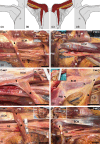Axillary arch (of Langer): A large-scale dissection and simulation study based on unembalmed cadavers of body donors
- PMID: 37965841
- PMCID: PMC10862185
- DOI: 10.1111/joa.13976
Axillary arch (of Langer): A large-scale dissection and simulation study based on unembalmed cadavers of body donors
Abstract
Connective or muscular tissue crossing the axilla is named axillary arch (of Langer). It is known to complicate axillary surgery and to compress nerves and vessels transiting from the axilla to the arm. Our study aims at systematically researching the frequency, insertions, tissue composition and dimension of axillary arches in a large cohort of individuals with regard to gender and bilaterality. In addition, it aims at evaluating the ability of axillary arches to cause compression of the axillary neurovascular bundle. Four hundred axillae from 200 unembalmed and previously unharmed cadavers were investigated by careful anatomical dissection. Identified axillary arches were examined for tissue composition and insertion. Length, width and thickness were measured. The relation of the axillary arch and the neurovascular axillary bundle was recorded after passive arm movements. Twenty-seven axillae of 18 cadavers featured axillary arches. Macroscopically, 15 solely comprised muscular tissue, six connective tissue and six both. Their average length was 79.56 mm, width 7.44 mm and thickness 2.30 mm. One to three distinct insertions were observed. After passive abduction and external rotation of the arm, 17 arches (63%) touched the neurovascular axillary bundle. According to our results, 9% of the Central European population feature an axillary arch. Approximately 50% of it bilaterally. A total of 40.74% of the arches have a thickness of 3 mm or more and 63% bear the potential of touching or compressing the neuromuscular axillary bundle upon arm movement.
Keywords: axilla; axillopectoral muscle; chondroepitrochlearis muscle; thoracic outlet syndrome; variation.
© 2023 The Authors. Journal of Anatomy published by John Wiley & Sons Ltd on behalf of Anatomical Society.
Conflict of interest statement
The authors declare that they have no known competing financial interests or personal relationships that could have appeared to influence the work reported in this article.
Figures




Comment in
-
What is the axillary arch (of Langer)?J Anat. 2024 Jul;245(1):197-198. doi: 10.1111/joa.14037. Epub 2024 Mar 6. J Anat. 2024. PMID: 38444373
References
-
- Ando, J. , Kitamura, T. , Kuroki, Y. & Igarashi, S. (2010) Preoperative diagnosis of the axillary arch with multidetector row computed tomography and the axillary arch in association with anatomical problems of sentinel lymph node biopsy. Breast Cancer, 17, 3–8. - PubMed
-
- Besana‐Ciani, I. & Greenall, M.J. (2005) Langer's axillary arch: anatomy, embryological features and surgical implications. The Surgeon, 3, 325–327. - PubMed
-
- Boontje, A.H. (1979) Axillary vein entrapment. British Journal of Surgery, 66, 331–332. - PubMed
-
- Chiba, S. , Suzuki, T. & Kasai, T. (1983) A rare anomaly of the pectoralis major? The chondroepitrochlearis. Okajimas Folia Anatomica Japonica, 60, 175–185. - PubMed
MeSH terms
LinkOut - more resources
Full Text Sources

